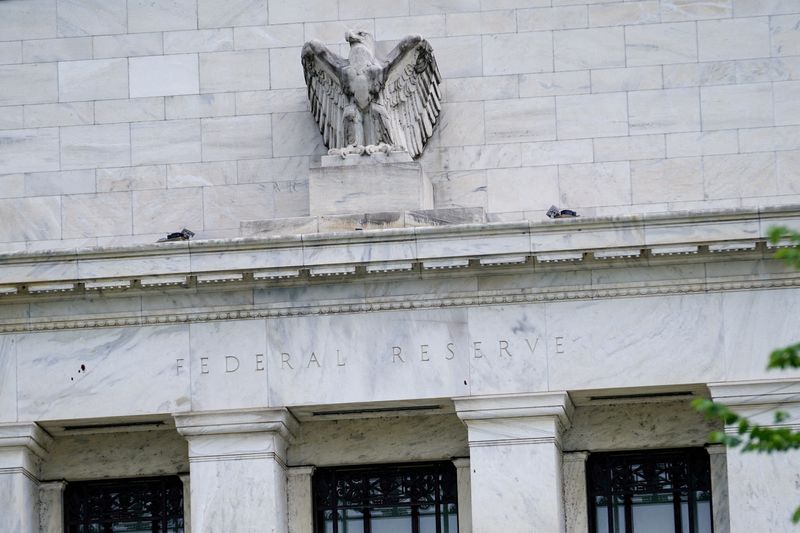By Jamie McGeever
ORLANDO, Florida (Reuters) -"Up the escalator, down the elevator shaft" is a well-worn FX market maxim describing the dollar's typical moves against the yen. The U.S. currency tends to rise steadily over time, but when it turns, it can plunge rapidly.
It is equally applicable to U.S. interest rates, and describes what we may be about to witness as an unusually large wave of volatility crashes over world markets.
Fed rate-hiking cycles are often conducted gradually, at former Fed Chair Alan Greenspan's famous "measured pace". But not easing cycles.
History shows that rate cuts are often large, aggressive and reactive because policymakers are forced onto the back foot and into frantically responding to damaging forces spiraling out of control, like recession or severe financial market dislocation.
Or both.
Or put another way, the economy practically never enjoys the fabled "soft landing". Instead, it's often facing an emergency landing. And that's because lagging behind is more a feature of Fed policy than a bug.
HISTORY LESSON
Chicago Fed President Austan Goolsbee said on Friday it was the central bank's job to act in a "steady" way. A Fed paper in May titled "Lessons from Past Monetary Easing Cycles" concluded that "successful policy management appears more likely when policymakers act early, more parsimoniously, and preemptively".
But despite their best intentions, policymakers' reaction function is rarely steady.
Since 1990, the central bank has raised rates 51 times and cut them 46 times. This may seem a little surprising given that inflation was below target for much of that time.
But rate cuts have been more aggressive than hikes, perhaps understandably in light of the dotcom crash, global financial crisis and COVID-19 pandemic. The fed funds rate fell to virtually zero in two of these episodes, and, in one case, it stayed there for almost seven years.
The policy rate has been raised by a quarter of a percentage point 40 times, and by half a percentage point or more 11 times. Until the surge in global inflation after the pandemic and Russia's invasion of Ukraine, the Fed had raised rates by 75 basis points only once, in November 1994. It did so four times in the most recent hiking cycle.
That compares with 28 quarter-point cuts since 1990 and 18 reductions of 50 bps or more, including seven cuts of 75 bps or more.
There have only been two Fed easing cycles in the last 40 years that could be characterized as smooth and gradual: the early 1990s when most of the 525 bps of cuts were delivered in quarter-point clips, and the mid-1990s when recession was averted with only three quarter-point cuts over eight months.
DESIGN FLAW
In many ways, the Fed is a victim of its own strategy. It is a data-driven, consensus-driven decision-making body, so it has to see the hard economic data first before it acts. Given that it often relies on lagging indicators, it will, by definition, almost always be "behind the curve". Its challenge is to ensure that this lag is as short as possible.
Its other option is not much better. Bob Elliott, CEO at Unlimited Funds and a former executive at Bridgewater, says the Fed's "fundamental construct" means it is a reactive institution with limited powers of prediction, so it is better to observe than predict.
"The alternative is to manage policy based upon predictions and trying to get ahead of the curve. Evidence suggests the Fed has little to no ability at predicting what is going to happen," Elliott says.
Others are less charitable, however. They argue that it is absolutely the Fed's job to be proactive in calibrating policy so that it meets its twin goals of "maximum employment and stable prices" and ensures financial stability.
"It's dangerous to have ignored all the recession indicators, just as they did in 2008," says David Blanchflower, professor of economics at Dartmouth College and former Bank of England rate-setter. "They are now playing catch up as the bad data comes in."
UNPRECEDENTED
Will this time be different? When the Fed paper mentioned above was published in May, the rates market was pricing in around 125 bps of Fed easing between then and the end of 2025. But as the paper's authors noted, "Compared to the historical record, such shallow easing after roughly a year and half from the start of easing would be unprecedented."
May seems like a long time ago. Stock prices and bond yields are tumbling rapidly now, and the VIX volatility index - Wall Street's "fear index" - is at its highest-ever level except for 2008 and 2020.

If history is any guide - rates were slashed to zero in those two instances - we should be looking out for that elevator shaft.
(The opinions expressed here are those of the author, a columnist for Reuters)
(By Jamie McGeever;Editing by Helen Popper)
